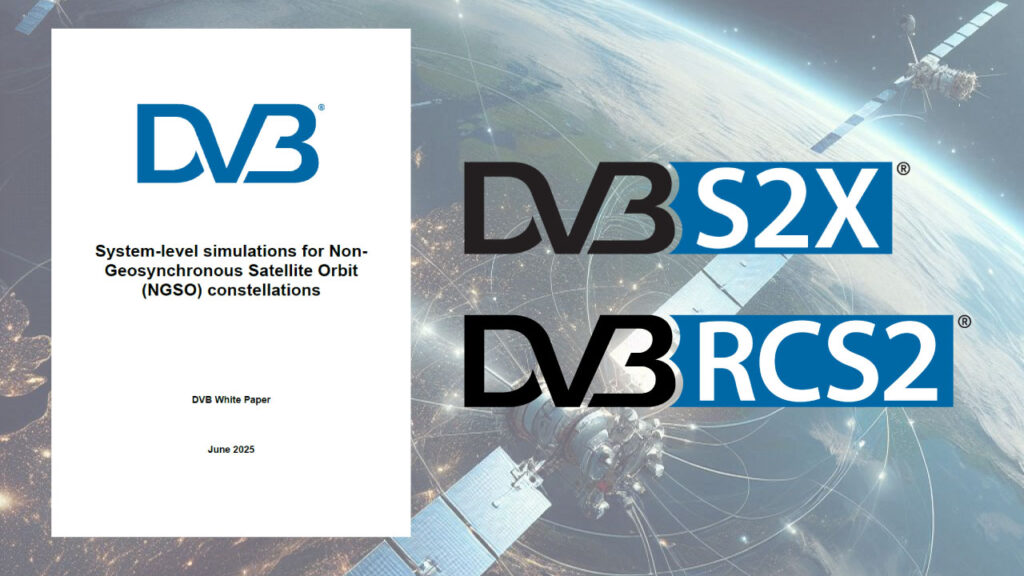
Simulations demonstrate the high performance of DVB’s specifications for NGSO satellites
In the world of satellite connectivity, a new generation of networks is revolutionizing how we connect across the globe. So-called Non-Geosynchronous Satellite Orbit (NGSO) constellations are networks of satellites orbiting the Earth at lower altitudes and higher speeds than traditional geostationary satellites. Such systems (examples below*) aim to deliver high-speed broadband to even the most remote corners of the planet, promising low delay and massive capacity.
But with this innovation comes complexity. How do we ensure that such advanced satellite systems are built on technologies that are robust, efficient, and future-proof? That’s where standards matter – and why recent research commissioned by the DVB Project is so significant.
Why standards matter in space
When satellite operators and manufacturers use common technical standards, they unlock an ecosystem of interoperability, scalability, and innovation. Open standards help avoid vendor lock-in, promote competition, and reduce development costs. They enable equipment from different suppliers to work seamlessly together, speeding up deployment and ensuring long-term viability.
The DVB Project offers a well-proven suite of standards for satellite communications, most notably DVB-S2X for the forward (download) link and DVB-RCS2 for the return (upload) link. Recent updates to these standards are designed to meet the unique demands of NGSO satellite constellations.
The latest test results
New independent simulations commissioned by the DVB Project and carried out by Magister Solutions have shown that DVB’s solutions for NGSO systems can outperform alternatives under real-world conditions. A series of in-depth system-level simulations compared the performance of DVB-S2X and DVB-RCS2 to the return link standard developed by 3GPP as part of the wider 5G system. The latter is termed NR-PUSCH, referring to the Physical Uplink Shared Channel that transmits data from mobile devices back to the network in a 5G New Radio (NR) environment.
Magister Solutions looked at how the different technologies handled one of the most challenging aspects of NGSO operation: Doppler shift. This is the frequency change caused by the high-speed movement of satellites relative to the user – something much more pronounced in NGSO systems compared to geostationary or ground-based networks. Since satellite trajectories are predictable, most of the Doppler shift can be compensated and the tests were performed for varying levels of compensation, simulating real-life conditions such as antenna tracking and satellite movement.
The findings, summarized in a new DVB White Paper, are compelling:
- DVB waveforms showed greater resilience to Doppler effects, especially at moderate compensation levels. This matters because not all terminals will have access to ultra-precise GPS data needed for perfect Doppler correction.
- DVB-S2X matched or exceeded 5G throughput performance under ideal conditions and pulled ahead when Doppler correction was less than perfect.
- DVB’s single-carrier approach helped avoid interference issues that can negatively affect the multi-carrier format used in 5G, making the DVB solution a better fit for satellite conditions.
What does this mean in plain terms? In the real world, where terminals vary in capability, and conditions are far from ideal, DVB specifications offer stronger, more reliable performance. That can translate into a major win for operators looking to deploy NGSO services that are both high-quality and cost-effective.
A complete, open solution
With the latest enhancements, DVB now offers a complete, open standard for NGSO satellite systems, covering both forward and return links, and validated against real-world operational models. This technical milestone means that operators, manufacturers, and service providers can confidently rely on DVB’s open specifications to build NGSO-based services.
The White Paper about this work provides an overview of the data behind these conclusions and more detailed explanations. It also includes a link to the original report from Magister Solutions.
* Examples of NGSO systems include SpaceX’s Starlink, Eutelsat’s OneWeb, O3b from SES, Amazon’s Project Kuiper, Telesat’s Lightspeed, and others.
